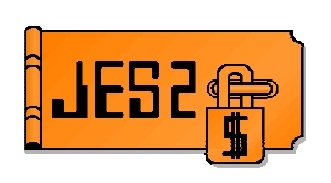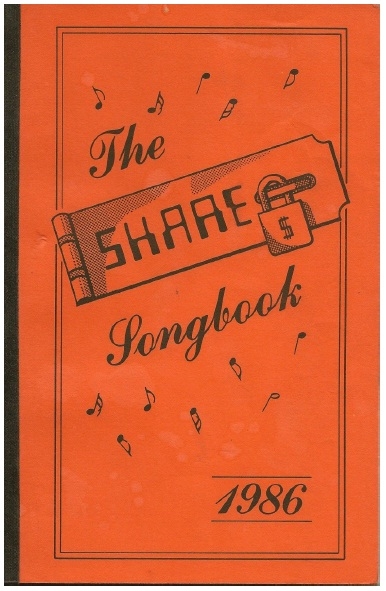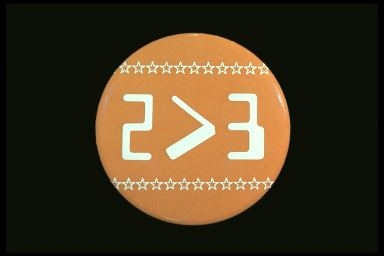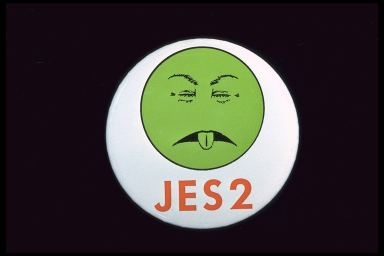From the perspective of long time SHARE volunteer and JES expert Jack Schudel, I pass along this interesting and entertaining article from Jack about the history of JES2/3; the names, the color orange, songs and buttons at SCIDS, and of course, the pioneers.
Enjoy, dear readers!
Mary Anne

z/OSsyGirl
History of JES2- by Jack Schudel
In the mid-1960's a small group of IBM employees working at the Manned Spacecraft Center in Houston worked on a program called HASP (please see next section for "How HASP got its name") which eventually was made available as an FDP. Its popularity and use expanded such that by February 1971 IBM released HASP II Version 3.0 as a Type III product with Class A support. This HASP ran as an optional extension to OS/MVT, performing the peripheral functions associated with job processing. In March of 1973 IBM released the SVS (i.e. OS/VS2 Release 1) operating system using a new version of HASP referred to as Version 4.0 HASP II Version 4.0 was not a System Control Program (SCP). It was still optionally available to replace OS/VS2 Release 1 readers and writers and continued to be a Class A service. With the availability of OS/VS2 Release 2 (MVS), HASP's name was changed to JES2.
JES2 now runs as an operator started task in its own address space, providing I/O spooling for local and remote unit record devices. Unlike its predecessor, HASP, JES2 is an integral part of the SCP, and receives the appropriate service support. In 1978 IBM Further enhanced the JES2 product with the announcement of Network Job Entry (NJE). How HASP got its name
Although HASP, and its successor, JES2, are well known and widely used, few people know the origins of the name. If you were to ask the hundreds of HASP fans, recognizable at SHARE by their many orange talismans, most would not know. A few would give the wrong, IBM perpetuated answer.
For the truth we must go back to the mid 1960's. IBM's OS/360 was in trouble. The spooling (wonder where that name came from) support was slow and the overhead was high. Many programming groups independently attacked the problem. ASP, loosely based upon the tightly coupled IBM 7090/7094 DCS, held the lead in the OS/360 spooling sweepstakes. ASP's need for at least two CPU's fit well with IBM Marketing's plans for the System/360. Meanwhile, a group of IBM SE's, located in Houston, developed a different product of which they were justifiably proud. They wanted to popularize it, as they correctly suspected it would be the balm for OS/360 users, increasing the usability and popularity of the operating system, and, not incidentally, furthering their careers. All they needed was the right name! A name which was easy to remember, a name which would draw attention to their product, and a name to distract from the ASP publicity. That name was Half-ASP, or HASP. Naturally, if HASP and ASP were products of two different companies, the FTC would have stepped in to stop such a predatory product name. Regulatory action was prevented, however, because IBM is "one big happy family", believed by many to be larger than the Government.
The new HASP erased some of ASP's publicity lead and capitalized on the rest. Because the "H" sound is nearly silent in English, no discussion of spooling systems for OS/360 could be carried on without mention of both products. HASP adherents quickly discovered that a picture of a hasp could symbolize their product's security and confidence. Further, the ASP people were opposed to begin using a poisonous viper for their logo.
Where, then, did the wrong answer come from? IBM could not live with Half-ASP, so their name calling department went to work and came up with: Houston Automatic Spooling Priority System (HASPS). Close enough for IBM work.
Why Orange?
Many users of HASP and JES2 are well aware that the color ORANGE seems to predominate our product, but few are aware of its origins. Some have proposed that it is a reference to the citrus fruit in order to avoid the other citrus fruit connotation of LEMON. But this is NOT true. Others have suggested the color was picked as a challenge for those writing songs for the Sing-Along because there are only two known words that rhyme with Orange. (It is left as an exercise to the reader to find them.) But this also is not true. What is even worse is that some jealous ASP (or JES3) users have joked that Orange is one half of a halloween prank. Of course that is definitely not the reason for our use of the color Orange.
The truth of the matter is that HASP was written by Tom Simpson in 1964 while he was working for IBM at the Manned Space Craft Center in Houston. Bob Crabtree and Dick Hitt were also involved in the original package that was released as the FDP. When Tom came to his first SHARE meeting he always carried and signed things with an Orange pen. The reason he did this had nothing to do with HASP at that time, it was because is alma mater's colors (University of Texas) were Orange and White. Since Tom was "Mr. HASP", it did not take long for people to start associating Orange with HASP.
A Perspective on JES2 Buttons and Songs
Few SHARE attendees appreciate the part that buttons and Thursday evening songs play in the history of IBM's operating system. These events, and the HASP and JES2 projects in SHARE, influenced the four major turning points in the history of the operating system.
Early System/360 and HASP -- Mid 1960's
System/360 software delays precipitated crises at many computer centers. Some installations had outgrown the hardware they had. Prospective users of larger System/360s planned to use either OS/360, the batch operating system, or TSS/360, the time sharing system. Both products were late. Versions of OS/360 were shipped with the 360 hardware, but those versions offered either no multi-programming (PCP), or multi-programming with only one batch partition (MFT). TSS/360 was delivered so late that in its prime only about a dozen installations ran it.
The HASP and ASP systems, both developed by IBM SEs in the mid-1960s, provided the spooling support installations needed to run OS/360. Without spooling, installations had to let OS/360 crawl using a card reader and line printer directly, or buy a second machine to process SYSIN and SYSOUT tapes. Admittedly, the single batch partition was a bottle-neck, but one could live with it.
Systems programming was very hard then. Few of the tools we have today were around then, and life was difficult. Midnight to dawn machine shots were common. The HASP system greatly improved OS/360 usability and performance, and was well liked. In retrospect, it seems natural that the first SHARE button should appear in March, 1968, worn by Tom Simpson, reading "I Like HASP". Similarly, knowing Dick Hitt's musical ability, it seems natural that he would sit down at a piano in SCIDS at SHARE XXXI in Atlantic City in October, 1968, and, with Tom and Bob Crabtree, start a sing-along which has become tradition. The song "HASPY Days are Here Again" dates from the earliest sing-alongs. The presence of the HASP developers at SHARE was part of the reason for its popularity.
MVT Released -- Mid 1967
MVT, the operating system designed for the larger System/360s, was finally shipped in late 1967. According to eyewitnesses, attendees at SHARE XXX, in Houston, in February, 1968, listened attentively to IBM's announcement that HASP would not be necessary with MVT, which had its own spooling. Some listeners struggled with the decision between MVT without HASP and a CDC 6600! Others, particularly those pioneers who had done some running under MVT, insisted that MVT spooling and console support represented major steps backwards for the HASP shops. Faced with this user pressure, IBM relented, and HASP II was born. The badge which shows an OS/360 rocket with the HASP II booster reflects user satisfaction with this programming announcement. Since HASP was originally developed for NASA, the rocket symbol is particularly apt.
Meanwhile, the base operating system went to virtual addressing. SVS provided 16 megabytes of virtual storage and operated otherwise much like MVT. HASP 4.0 was provided as a growth path for HASP II users. MVS provided each user with 16 megabytes of virtual storage, partly private and partly shared. JES2 was provided as a growth path for HASP users.
Then, in 1973, at SHARE, IBM indicated that JES2 was a dead-end product. They said that improvements like remote networking and shared spool would be provided only in the JES3 spooling system. The HASP community went into shock.
Shared Spool
Systems programmers at the National Institutes of Health developed a modified version of HASP which allowed multiple systems to use a common queue. Despite the size of the modification, and the size configuration required to use it, several other installations installed the modification. The Mellon Bank, in Pittsburgh, was one such installation. However, there was strong user interest in IBM support of a shared spool function. The "My Spool is Shared" button to this effect appeared in 1968.
IBM's plan for MVS direction heated up the discussion considerably. In May, 1973. Tod Dixon (AEP), Chuck Forney (PSU), Joe Naughton (NIH), and Bill Redfield (AVA) met with Al Scherr, the father of MVS, and Gail Aguilar, head of large systems marketing of IBM, to discuss the lack of a future for shared spool. One foil from their presentation, which depicts two HASP systems shaking hands and symbolizes shared spool, later became a popular sticker at SHARE XLIV in Los Angeles in February, 1975. "Multi-Access", to the tune of "Rubber Ducky" also symbolizes the mood of the times.
In March, 1975, IBM announced JES2 for MVS Release 3.0, including shared spool. SHARE, the JES2 project, and IBM enjoyed a major victory for the industry.
Network Job Entry
Just as NIH and Mellon pioneered shared spool, Triangle Universities Computer Center, the University of Iowa, and Martin Marietta used a package called HASP-to-HASP to move jobs and output between data centers. IBMs plan for a stabilized JES2 system flew in the face of users planning for that sort of function.
After receiving several requirements, IBM described their Subsystems Unified Network (an IBM internal networking system) to the SHARE Computer Networking project in November, 1974. A button reading "Let the SUN Shine Out" describes the attendees reaction to the presentation very well.
After receiving several requirements, IBM described their Subsystems Unified Network (an IBM internal networking system) to the SHARE Computer Networking project in November, 1974. A button reading "Let the SUN Shine Out" describes the attendees reaction to the presentation very well.
Conclusion
Although the buttons and songs are designed for fun, they often serve the very serious purpose of promoting our ideas to IBM and others at SHARE. Never think of attendees at SHARE "just" singing songs or wearing buttons.
That is the end of Jack's article. The rest are JES2 tidbits from z/OSSYgirl.

In Denver the project produced a JES2 'Orange Card' with the sessions relating to JES:
JES2 Orange Card in word format: http://www.share.org/p/do/sd/topic=139&sid=7441

This image is stolen from John Eell's fabulous presentation in zNextgen, A SHARE'd History of the Mainframe: The Chronicles, Artifacts and Stories You can view the entire presentation here:
https://share.confex.com/share/116/webprogram/Handout/Session9022/SHARE%20116%20Session%209022.pdf
Buttons 374 and 437, from Barry Merrill's collection, show the rivalry between JES's:


You can see Barry's collection at:
Barry Merrill 'The Button Man' site, with 1291 button images http://www.mxg.com/thebuttonman/search.asp
PS: Barry, what an amazing labor of love!